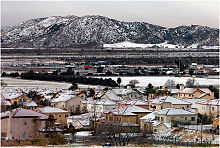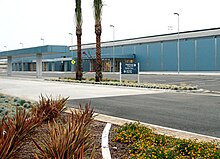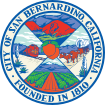This is an old revision of this page, as edited by House1090 (talk | contribs) at 18:27, 31 January 2010 (added 2nd reference). The present address (URL) is a permanent link to this revision, which may differ significantly from the current revision.
Revision as of 18:27, 31 January 2010 by House1090 (talk | contribs) (added 2nd reference)(diff) ← Previous revision | Latest revision (diff) | Newer revision → (diff)
The San Bernardino Valley, sometimes referred to as the Greater San Bernardino Area, lies at the south base of the Transverse Ranges. It is bordered on the north by the eastern San Gabriel Mountains and San Bernardino Mountains, on the east by the San Jacinto Mountains, and on the south and west by the Santa Ana Mountains and Pomona Valley. Elevation varies from 180 metres (590 ft) on valley floors near Chino, where it gradually increases to about 420 metres (1,380 ft) near San Bernardino and Redlands. The valley floor houses roughly over 80% of the over 4 million total human population in the Inland Empire region, one of the most important industrial and residential areas of Southern California and the 14th largest metropolitan area in the United States.
History
The San Bernardino Valley was originally inhabited by Native Americans including the Serrano Tribe. Early colonization was done by Mormons, who still have a sizable presence in the area.

Geography

The San Bernardino Valley was cut from fast moving water flows from mountain ranges in the north, east and south that collectively drain into the Santa Ana River basin that goes to the sea through Riverside and Orange County. The valley connects several open natural areas and beautiful mountain and valley vistas. The San Bernardino Valley is surrounded by preserves, national forests and open recreational areas. For this reason many residents travel through the area for a variety of outdoor sports, including skiing, hiking, biking and ballooning in the mountain resorts of Crestline, Lake Arrowhead and Big Bear City.
Once part of famed U.S. Route 66, it is now crossed by Interstate 15 on its way through the high desert. Interstate 10 enters the valley from Pomona and exits to the east over the San Gorgonio Pass, which enters into the low desert.
Joan Didion, in her essay "Some Dreamers of the Golden Dream," describes the San Bernardino Valley as "...in certain ways an alien place: not the coastal California of the subtropical twilights and the soft westerlies of the Pacific but a harsher California, haunted by the Mojave just beyond the mountains, devastated by the hot dry Santa Ana wind that comes down through the passes at 100 miles an hour and works on the nerves."
Cities and communities
Ontario and San Bernardino both serve as the economic engines of the Greater San Bernardino area with San Bernardino having the regions major downtown core. The county and region offices are located in San Bernardino.
Principal city
- Arrowhead Springs, San Bernardino
- Downtown San Bernardino
- University District, San Bernardino
- Devore, San Bernardino
- Muscoy, San Bernardino
Suburbs
- Colton
- Calimesa
- Fontana
- Grand Terrace
- Highland
- Loma Linda
- Oak Glen
- Ontario
- Rancho Cucamonga
- Redlands
- Rialto
- Yucaipa
Climate

The climate is Mediterranean with cool to cold, wet, in some cases snowy winters (extreme east and north valley areas) and dry, hot summers. Usually the areas north of interstate 210 and east of interstate 215 see colder weather in the winter with occasional snowfall. Sage scrub and the Yucca plant are the predominant natural vegetation along washes and uplands; it intergrades with chaparral at elevations of 600 to 700 m. Other vegetation consists of a patchwork of grasslands, riparian woodlands, and mixed hardwood forests, which border the valley in the mountains on the north and east. The Santa Ana winds blow into the valley from the Cajon Pass, which exits the valley's north end between the San Gabriel and San Bernardino mountains. The seasonal Santa Ana winds are felt particularly strongly in the San Bernardino area as warm and dry air is channeled through nearby Cajon Pass at times during the autumn months. This phenomenon markedly increases the wildfire danger in the foothill, canyon, and mountain communities that the cycle of cold wet winters and dry summers helps create.
| Monthly Normal High and Low Temperatures for San Bernardino | |||||||||||||
| Month | Jan | Feb | Mar | Apr | May | Jun | Jul | Aug | Sep | Oct | Nov | Dec | Year |
|---|---|---|---|---|---|---|---|---|---|---|---|---|---|
| Avg high °F | 62 | 66 | 68 | 71 | 77 | 91 | 102 | 103 | 89 | 80 | 71 | 64 | 75 |
| Avg low °F | 34 | 35 | 41 | 46 | 50 | 53 | 60 | 60 | 57 | 50 | 42 | 37 | 46 |
Local attractions
The Route 66 Rendezvous in downtown San Bernardino attracts about half a million people annually from all over the world to watch California's largest classical car show . Although not in the valley, the San Bernardino Mountains attract much tourism to the valley as people drive up to the local resorts, especially in the winter months. A famous ski resort in the area is Big Bear. Other famous mountain communities with large tourism include Lake Arrowhead, Big Bear Lake, and Crestline.
National forests surrounding the high valley include the Cleveland National Forest and the San Bernardino National Forest.
Sports

The San Bernardino Valley is home to a lot of number of different of sport teams. Including the California State University, San Bernardino Coyotes compete at the NCAA Division II level in a variety of sports. In 2007, the Coyotes' men's basketball team competed in the Division II Final Four in Springfield, Massachusetts. However, only San Bernardino Valley College plays football at the collegiate level.
San Bernardino also hosts the BSR West Super Late Model Series at Orange Show Speedway. The series fields many drivers, including NASCAR Camping World Truck Series regular Ron Hornaday, who drove the #33 in a race on July 12, 2008.
Inland Empire 66ers
San Bernardino city hosts the Inland Empire 66ers of San Bernardino baseball club of the California League. The 66ers play at Arrowhead Credit Union Park in downtown San Bernardino.
Rancho Cucamonga Quakes
The Rancho Cucamonga Quakes are a minor league baseball team in Rancho Cucamonga. They are a "high-A" class team in the California League, and have been a farm team of the Los Angeles Angels of Anaheim since 2001, when they switched affiliations with the Lake Elsinore Storm. They were affiliated with the San Diego Padres during the late 1990s. The RC Quakes play at the Rancho Cucamonga Epic Center.
Little League baseball
San Bernardino is also the home of Al Houghton Stadium and the Western Regional Little League headquarters of Little League Inc. Each year in the first two weeks of August, San Bernardino hosts eleven western states in the West and Northwest regional tournaments. The winner of each tournament goes onto the Little League World Series in Williamsport, Pennsylvania. The championships games each year are televised by ESPN.
Auto Club Speedway
Auto Club Speedway, a racetrack located in the city of Fontana, plays host to two NASCAR Sprint Cup events a year and various smaller races. It was built on the former site of the Kaiser Steel mill.
Education
The Greater San Bernardino area is home to several cities. Some of which have their own school districts while others contract with neighboring cities to provide schooling. Notable ones would be the award winning Redlands Unified School District and largest school district in the area, the San Bernardino City Unified School District. The Valley is also home to one campus of the California State University system as well as three community colleges. In addition, some private institutions are located in the Valley as well as various trade and technical schools.
School Districts
- Colton Joint Unified School District
- Fontana Unified School District
- Rialto Unified School District
- Redlands Unified School District
- San Bernardino City Unified School District
- Yucaipa-Calimesa Joint Unified School District
Community Colleges
Universities
Transportation
Although a significant number of the cities and towns are "bedroom communities" with residents commuting to nearby Los Angeles or Orange counties for work, the San Bernardino Valley is still an important transportation center to the state and country. Located approximately 70 miles to the east, the Ports of Los Angeles and Long Beach, a high percentage of goods destined for the rest of the country as well as items on their way out to the world pass through the valley, most of it on trains or trucks. Both Union Pacific and BNSF have tracks that run through the valley. In addition, BNSF has an intermodal transfer facility in San Bernardino. The valley is also crossed by two major interstates and their auxiliaries. Additionally, the communities in the mountains north of the valley are served by several state highways. Mass transit trains and buses both serve the valley. And goods and people movement by air is available via two commercial international airports as well as several general aviation air fields. The Greater San Bernardino Area along with the rest of the Inland Empire, is rank by Forbes Magazine as one of the American's unhealthiest communtes.
Interstate Highways
 San Bernardino Freeway (Interstate 10)
San Bernardino Freeway (Interstate 10) Interstate 15
Interstate 15 Foothill Freeway (Interstate 210)
Foothill Freeway (Interstate 210) Interstate 215
Interstate 215
State Highways
 State Route 18
State Route 18 State Route 38
State Route 38 State Route 66
State Route 66 State Route 138
State Route 138 State Route 210 (formerly
State Route 210 (formerly  State Route 30)
State Route 30) State Route 330
State Route 330
Mass Transportation
Although high percentage of valley residents drive their own cars, there are several available options for mass transit. The largest bus line in the Greater San Bernardino area is Omnitrans, which covers virtually the entire valley. The Omni lines also meet lines for Foothill Transit and Riverside Transit Agency buses, providing connectivity to Riverside County and Los Angeles County. The area is also served by Metrolink's San Bernardino Line and the IEOC Line. These lines lead to the Los Angeles Metropolitan and San Diego Metropolitan areas.
Railroad
The two main railroads in the valley are Union Pacific (UP) and BNSF. Both have extensive yards in the valley and it is an important area for national movement of goods. UP tracks enter the valley from the south alongside the BNSF tracks in Colton/Grand Terrace. They then continue north until the Colton Crossing, where they then turn east. Union Pacific also has a second set of tracks that were the Southern Pacific tracks until they took over SP. These tracks enter the valley from the west through Ontario, passing alongside the 10 until Loma Linda, where they turn and exit the valley to the southeast. The BNSF track enters the valley from the south by Colton/Grand Terrace as well, but continues north at the Colton Crossing. It then enters the intermodal and car transfer yards, where it turns east for approximately a mile. It then turns north again, running alongside I-215 until it meets the 15 in Devore and exits the valley via the Cajon Pass. Union Pacific also has a line that exits the valley through the pass. The Colton Crossing, located in Colton, is the point where the tracks of the two companies cross.
Airports

The San Bernardino Valley is served by two major commercial airports, although it has many gerneral aviation airports.
| Airport | IATA code | ICAO code | County |
|---|---|---|---|
| Ontario International Airport | ONT | KONT | San Bernardino |
| San Bernardino International Airport | SBD | KSBD | San Bernardino |
See also
Gallery
- San Bernardino skyline San Bernardino skyline
-
 Juncture of the San Gabriel and San Bernardino Mountains. The I-210 (Foothill Expressway) runs parallel, I-215 intersects leading to the Cajon Pass.
Juncture of the San Gabriel and San Bernardino Mountains. The I-210 (Foothill Expressway) runs parallel, I-215 intersects leading to the Cajon Pass.
-
 Artificial color image of smoke from Oct 2003 wildfires covering the Greater San Bernardino Area
Artificial color image of smoke from Oct 2003 wildfires covering the Greater San Bernardino Area
References
- Hall, Clarence A. (2007-10-07). Introduction to the geology of southern California and its native plants. University of California Press. p. 173. ISBN 0520249321, 9780520249325.
{{cite book}}: Check|isbn=value: invalid character (help) - Powell, Robert E. (1993). The San Andreas fault system. Geological Society of America. pp. vii, 5, 150, 151. ISBN 0813711789, 9780813711782.
{{cite book}}: Check|isbn=value: invalid character (help); Unknown parameter|coauthors=ignored (|author=suggested) (help) - ^ Mian, Lal S. (December, 2000), Inland Empire Environmental Quality Paradigm (PDF), San Bernardino: California State University, San Bernardino, Department of Health Science and Human Ecology, retrieved 2007-12-16
{{citation}}: Check date values in:|date=(help) - ^ Davis, Liam H. (1998). "History and Status of the California Gnatcatcher in San Bernardino County" (PDF). Western Birds. 29 (4). Organization of Western Field Ornithologists: 361–365. Retrieved 2007-12-17.
{{cite journal}}: Unknown parameter|coauthors=ignored (|author=suggested) (help) - Water Resources Institute, California State University, San Bernardino (2004), The Santa Ana River and Watershed Bibliography (PDF), Redlands: Redlands Institute, University of Redlands, retrieved 2007-12-17
{{citation}}: CS1 maint: multiple names: authors list (link) - Didion, Joan (1968), "Some Dreamers of the Golden Dream", Slouching Towards Bethlehem: Essays, New York: Farrar, Straus and Giroux
- Howard, Bob (2001-10-02). "Building on Ontario's Success". Los Angeles Times. ISSN 0458-3035. Retrieved 2009-07-08.
- Weatherbase. San Bernardino Valley
- Route 66: Route 66 Rendezvous
- San Bernardino National Forest. San Bernardino National Forest
- Inland Empire 66ers. Inland Empire 66ers of San Bernardino
- Rancho Cuccamonga Quakes. RC Quakes
- San Bernardino City Unified School District
- Van Dusen, Alison (2007-11-26). "America's Unhealthy Commutes". Forbes Magazine. Retrieved 2007-12-09.
- Omnitrans. Omnitrans: Serving the San Bernardino Valley
34°4′N 117°17′W / 34.067°N 117.283°W / 34.067; -117.283
| Inland Empire | |
|---|---|
| Counties | |
| Principal cities | |
| Cities and towns 100k+ | |
| Cities and towns 25k–100k | |
| Cities and towns 10k–25k | |
| Cities and towns under 10k | |
| Regions | |
| Topics |  | ||||
|---|---|---|---|---|---|
| History | |||||
| Areas | |||||
| Transportation |
| ||||
| Points of interest | |||||
| Education |
| ||||
| Sports | |||||